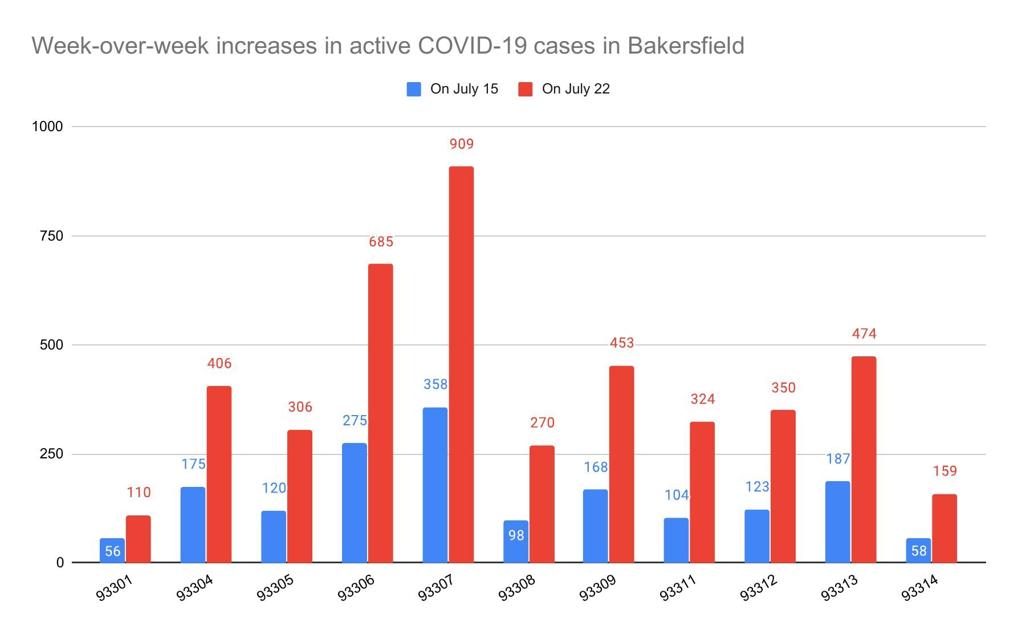
A staggering 1,120 new cases of COVID-19 were reported in Kern County on Wednesday, a nearly tenfold increase over the number of daily cases reported in recent weeks.
It is not simply amazing by our own measure. Kern has had the second or third highest number of daily cases of any county in the entire state in the past few days, behind only Los Angeles, San Bernardino and Riverside counties.
Why are Kern’s numbers so high?
It appears to be caused by a confluence of factors including high demand for testing, delays in processing testing, both in laboratories and when the county receives the results, and the simple fact that there is more widespread transmission of the disease in community.
The Kern County Department of Public Health Services said in a statement explaining the high case counts:
“Over the past few weeks we have seen a significant increase in testing at our county and state testing sites. Some of our sites have experienced a fourfold increase that has been sustained over the past few weeks.
“Contracted labs (Quest and Westpac) have notified us that they are experiencing a shortage of test supplies and laboratory reagents and their response time is extended with results not received for 7 days or more in many cases.
“This increase in testing and recently delayed results have resulted in a large number of laboratory results currently being received in Public Health. This increase in volume has overwhelmed our system and our personnel plan was unable to keep up. We have called more people within our department to help us and we have tripled staff in key areas. We spent early last week training and implementing the changes and we are making significant progress.
“This means that there will be a large increase in the number of positive tests to be reported in the coming weeks, if not more.”
Daily case counts do not reflect new cases in the last day or two, they generally represent cases in the last four or five days, although backlog testing has extended that time even further.
Similarly, the 10 new deaths reported Wednesday occurred more than a week ago or more, bringing the total to 115. The total number of cases across the county now exceeds 11,000 and the number of people examined is approaching 110,000 of a county population of 900,000.
In addition, local hospitals welcomed an additional 32 COVID-19 patients over a 48-hour period Sunday through Tuesday, according to a state hospital tracker.
In recent weeks, the number of new cases announced daily hovered around 100-150 per day, but on Saturday it reached nearly 500, and the number has increased every day since.
Extended tests
On Tuesday, Kern was again added to the state watch list of counties that are exceeding certain COVID-19 metrics.
The Kern State Watch List states website: “Possible drivers of elevated disease transmission include: 1) An exponential expansion of testing for residents of Kern County; 2) Transmission in nursing facilities specialized, prisons and other congregated facilities; 3) Domestic contacts and social gatherings between separate homes. “
County officials said earlier this week that the number of people screened began to rise rapidly earlier this month.
While around 20,000 tests were performed in the first 22 days of June, more than 40,000 were performed in the first 22 days of July, according to county figures.
Meanwhile, in a tweet on Wednesday, Rep. Kevin McCarthy, R-Bakersfield, said Health and Human Services had approved the surge tests in Bakersfield, meaning more tests will be available soon at no cost.
The surge test is approved for communities that see a sudden increase in cases and hospitalizations, according to HHS. It has been pre-approved in Jacksonville, Florida; Baton Rouge, La.; and Edinburg, Texas.
Some health experts said that beyond the increase in tests and delays, the virus is simply spreading more widely in the community.
Exponential growth
UC Irvine epidemiologist and associate professor of public health Andrew Noymer said the type of growth in the cases Kern is seeing is what ultimately happens in an exponential growth pandemic. The rate of increase is proportional to the size of the number of cases, he said.
“Exponential growth goes up and up and up. It’s like a rocket, “said Noymer, explaining that the cases in the last three weeks may be the same as the entire previous curve.
Dr. Hemmal Kothary, medical director of Dignity Health’s Central California division, said he believed the meetings on the past few days are likely to be driving the numbers. July 4th was just over two weeks ago, which is the incubation period for the virus. Father’s day was four weeks ago.
“I think it will eventually calm down a bit,” Kothary said of new cases.
But, he added, “I don’t think it will completely disappear before the second wave,” which he expects to arrive this fall.
The Sierra Vista Clinic, which operates health care clinics for the uninsured, has seen huge increases in cases at its South Bakersfield and Lamont centers, spokesman Tim Calahan said. In Lamont, the positive rate to date is 40 percent and in southern Bakersfield it is 29 percent.
“It’s triple,” Calahan explained.
Those areas are mostly Hispanic, a population that has been contracting the virus at higher levels at the state and national levels. People in those areas tend to be essential workers, so they “never stopped working during the pandemic.” And they tend to live in multi-generational homes with grandparents, children, and grandchildren living in the same house.
“With collective housing, all it takes is one person to spread that around the home,” Calahan said.
.